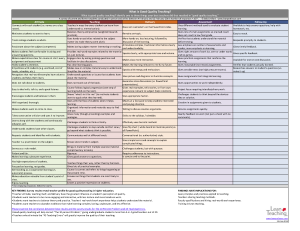The results of the survey are in! I was impressed by how many answers revolved around the same themes in terms of teacher’s attitude, teaching itself, and delivery. These three categories lay the foundation for good quality teaching. Surprisingly, assessment and follow-up, while, important, were areas of less concern to students when it comes to good quality teaching.
The survey results reveal a teacher profile for good quality teaching in higher education. The spreadsheet, below, can be used as a visual control by faculty to improve the quality of teaching. I hope many will do so. In addition, the survey results identify clear markers pertaining to students’ perception of value in higher education.
Key findings include:
- Teacher attitude, teaching itself, and delivery have the greatest influence on student’s perception of quality.
- Students want teachers to be more engaging and interactive, with less lecture and more hands-on work.
- Students want teachers to balance theory and practice. Teachers’ real-world work experience helps students understand the material.
- Students want teachers to abandon traditions that make learning complex, boring, unpleasant, and less effective.
These findings have important implications for:
- The application of continuous improvement methods to teaching.
- Teachers sharing teaching methods.
- Faculty qualifications and hiring, especially real-world work experience.
- Training in Lean teaching.
Click on the image below to enlarge (.pdf file).
Please examine the correlation between this survey and the survey results for “The 10 Percent Problem” and “45 Teaching Errors.” You will see that good quality teaching will help correct “The 10 percent Problem” and give undergraduate students more than just 3 or 4 good teachers out of 40. Also, teachers who eliminate the “45 Teaching Errors” will greatly improve the quality of their teaching.
Interestingly, these simple, inexpensive survey results are consistent with a more complex study of classroom teaching based on skilled observation of what teachers actually do in the classroom to determine what constitutes good teaching. Note, however, the study indicates that good teaching is “idiosyncratic by discipline and course.” In contrast, the survey results presented here suggest that students, themselves observers of teaching, do not value that distinction. Instead, they favor interactive teaching and connectivity to the “real world” over lecture no matter what the discipline or course is.
University leaders and faculty who embrace these survey results will improve teaching quality and achieve better educational outcomes for students. Those who don’t will suffer the consequences as students, over time, recognize the educational alternatives that are available to them.

